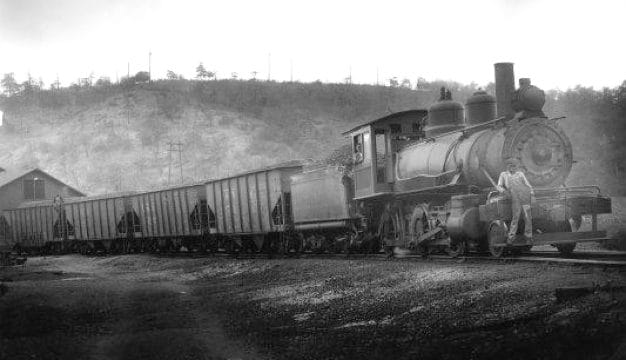Erskine Hawkins
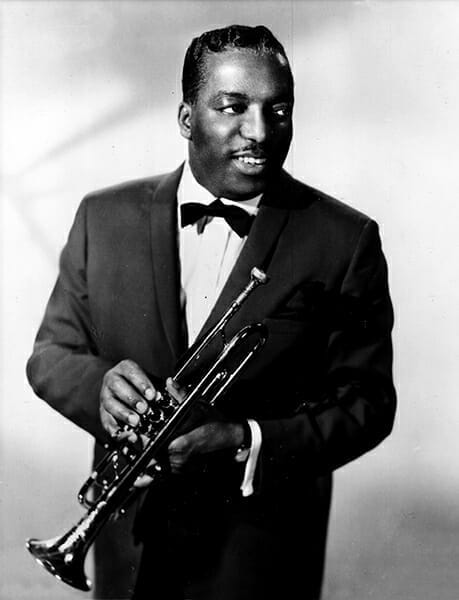 Erskine Hawkins
Musician and Birmingham native Erskine Hawkins (1914-1993) was a prominent African American trumpeter, bandleader, and composer during the Big Band era of the 1930s and 1940s. Known as the “Twentieth-Century Gabriel” (after the angel Gabriel, who is often depicted with a trumpet) for his flamboyant style and ability to hit high notes, Hawkins gained fame as a member of the ‘Bama State Collegians, one of the finest college bands of its time. His Erskine Hawkins Orchestra was a popular dance band in New York City, and with it he recorded “Tuxedo Junction” (1939) and several other hits. Hawkins is a member of the Alabama Music Hall of Fame and the Alabama Jazz Hall of Fame.
Erskine Hawkins
Musician and Birmingham native Erskine Hawkins (1914-1993) was a prominent African American trumpeter, bandleader, and composer during the Big Band era of the 1930s and 1940s. Known as the “Twentieth-Century Gabriel” (after the angel Gabriel, who is often depicted with a trumpet) for his flamboyant style and ability to hit high notes, Hawkins gained fame as a member of the ‘Bama State Collegians, one of the finest college bands of its time. His Erskine Hawkins Orchestra was a popular dance band in New York City, and with it he recorded “Tuxedo Junction” (1939) and several other hits. Hawkins is a member of the Alabama Music Hall of Fame and the Alabama Jazz Hall of Fame.
Born in the Enon Ridge section of Birmingham, Jefferson County, on July 26, 1914, Erskine Ramsay Hawkins was one of five children of Edward and Cary Hawkins. After his father died in France during World War I, the family moved in with Cary’s relatives across the street from the Tuggle Institute, a private school for African American boys (now Tuggle Elementary School). Hawkins attended Tuggle from the age of six, excelling in music and athletics. Under the direction of the school’s band director, he first played drums, trombone, and saxophone, before concentrating his talents on the trumpet. He was nearly always at the school, either playing music or at the gym, where he played basketball, football, and tennis.
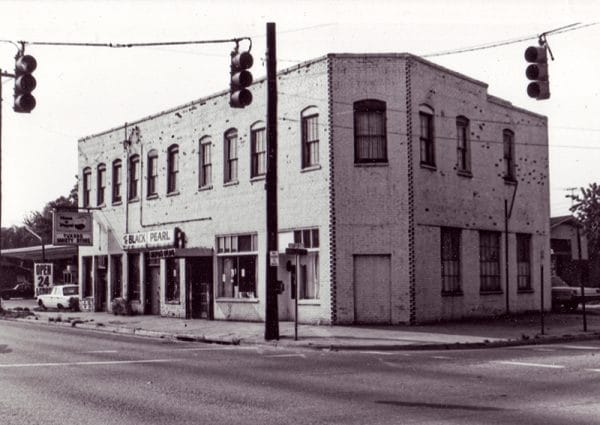 Nixon Building, Tuxedo Junction
Hawkins had a long-time relationship with Tuxedo Junction, a streetcar intersection on the Ensley-Fairfield line in Birmingham that was a center of nightlife for African Americans from the 1920s through the 1950s, comparable to Harlem in New York City. Music and dancing were plentiful at the juke joints and a fancy ballroom frequented by mill and railroad workers, who often rented tuxedos from a nearby shop. As a young child, Hawkins played music in the local park and was inspired by the sounds he heard. As a teenager, Hawkins attended Birmingham Industrial High School under famed music educator John T. “Fess” Whatley, and formed a band with Bob Range, Haywood Henry, and other boys from the school, eventually playing in Birmingham’s clubs.
Nixon Building, Tuxedo Junction
Hawkins had a long-time relationship with Tuxedo Junction, a streetcar intersection on the Ensley-Fairfield line in Birmingham that was a center of nightlife for African Americans from the 1920s through the 1950s, comparable to Harlem in New York City. Music and dancing were plentiful at the juke joints and a fancy ballroom frequented by mill and railroad workers, who often rented tuxedos from a nearby shop. As a young child, Hawkins played music in the local park and was inspired by the sounds he heard. As a teenager, Hawkins attended Birmingham Industrial High School under famed music educator John T. “Fess” Whatley, and formed a band with Bob Range, Haywood Henry, and other boys from the school, eventually playing in Birmingham’s clubs.
In 1930, at the age of 16, Hawkins graduated from Birmingham Industrial and moved to Montgomery to attend State Teachers College (now Alabama State University) on a tennis scholarship, but gave that up to major in music. Of the college’s three different bands at the time, the Collegians, the Revelers, and the Cavaliers, the best musicians played in the Collegians, which eventually included Hawkins and his friends Henry, Range, and Wilbur “Dud” Bascomb. In the early 1930s, the bands toured to make money for the school, with earnings beyond salaries and expenses sent to Montgomery. While touring the South and Midwest, the Collegians gained a reputation as one of the best college bands in the country. Led by J. B. Sims, it played jazz and dance tunes, but also military music and symphonic pieces. Hawkins graduated in 1934, but stayed on to teach music and play with the band.
 Erskine Hawkins
Hawkins and the Collegians first earned fame in 1934, when touring the Northeast. While in Asbury Park, New Jersey, musicians from New York City came to hear them play, and the band was invited to the Harlem Opera House and Brooklyn’s Fox Folly. Given the chance to turn professional and make more money, Hawkins and most members decided to stay in New York, with Hawkins replacing Sims as bandleader. During their first few years, they played various clubs in New York, including the Apollo Theater, as well as school dances and other venues, and continued touring. A bit rough and unpolished early on, the band developed a more refined hard-swinging approach popular with dancers. Specializing in medium-fast tempos, mixing swing tunes with ballads, and maintaining a bluesy quality, the band’s music reflected the influences of Louis Armstrong, Jimmy Lunceford, and Count Basie.
Erskine Hawkins
Hawkins and the Collegians first earned fame in 1934, when touring the Northeast. While in Asbury Park, New Jersey, musicians from New York City came to hear them play, and the band was invited to the Harlem Opera House and Brooklyn’s Fox Folly. Given the chance to turn professional and make more money, Hawkins and most members decided to stay in New York, with Hawkins replacing Sims as bandleader. During their first few years, they played various clubs in New York, including the Apollo Theater, as well as school dances and other venues, and continued touring. A bit rough and unpolished early on, the band developed a more refined hard-swinging approach popular with dancers. Specializing in medium-fast tempos, mixing swing tunes with ballads, and maintaining a bluesy quality, the band’s music reflected the influences of Louis Armstrong, Jimmy Lunceford, and Count Basie.
In 1935, Hawkins married Florence Browning, a schoolteacher. The following year, the band began recording for Vocalion Records as the ‘Bama State Collegians featuring Erskine Hawkins. By 1938 it was known as Erskine Hawkins (the Twentieth-Century Gabriel) and His Orchestra, to reflect the members’ independence from their former school. In 1938 members signed a recording contract with the RCA Bluebird, and later RCA Victor labels, a relationship that lasted until 1950. The band also found steady work at the Savoy Ballroom in Harlem, where it alternated with the Chick Webb Band so that dancers could have uninterrupted music each night. Eventually Hawkins and his orchestra became the Savoy house band and played there for several years, while also spending several months each year on the road. At the Savoy, Hawkins and his group often engaged in “battles of the bands” with guest bands, including Glenn Miller, Duke Ellington, and Lionel Hampton. For several years, concerts at the Savoy were also broadcast on the radio.
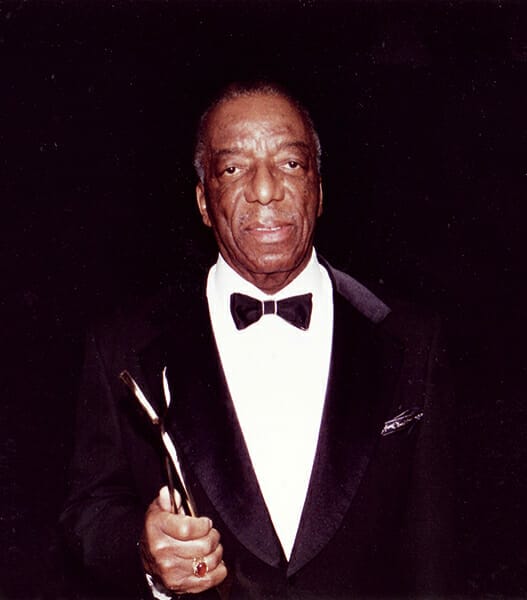 Erskine Hawkins
Hawkins’ group had some distinctive qualities that made the band both successful and stable. Hawkins shared trumpet duties with Wilbur Bascomb, an excellent trumpeter, and gave plenty of solo time and credit to other band members, such as Paul Bascomb and Julian Dash, both of whom played tenor sax. Many new compositions were written by William Johnson (sax) and Sammy Lowe (trumpet), and arrangement was shared by Lowe and Avery Parrish (piano). By all accounts, band members got along well and enjoyed working together.
Erskine Hawkins
Hawkins’ group had some distinctive qualities that made the band both successful and stable. Hawkins shared trumpet duties with Wilbur Bascomb, an excellent trumpeter, and gave plenty of solo time and credit to other band members, such as Paul Bascomb and Julian Dash, both of whom played tenor sax. Many new compositions were written by William Johnson (sax) and Sammy Lowe (trumpet), and arrangement was shared by Lowe and Avery Parrish (piano). By all accounts, band members got along well and enjoyed working together.
The band scored its first hit in 1939 with “Tuxedo Junction,” and the tune became its signature song for many years. The song had originated as the sign-off tune each band would play at the Savoy to signal that the next band should prepare to take the stage. During one recording session, they needed an extra song, and William Johnson created an arrangement on the spot. The song sold very well, but when the all-white Glenn Miller Orchestra recorded a version of the song, white audiences bought that instead, even though many jazz aficionados consider Hawkins’s version superior.
The band was very popular, especially among African Americans, but jazz critics at the time were less kind. They accused Hawkins of having poor intonation and of grandstanding with his flashy displays of trumpet high notes, were disdainful of his nickname, and judged the band unoriginal. Fans, however, considered Hawkins an outstanding trumpet player and bandleader. And his loyal following allowed him to keep the band together into the early 1950s, long after most other big bands had split up and musical tastes had changed.
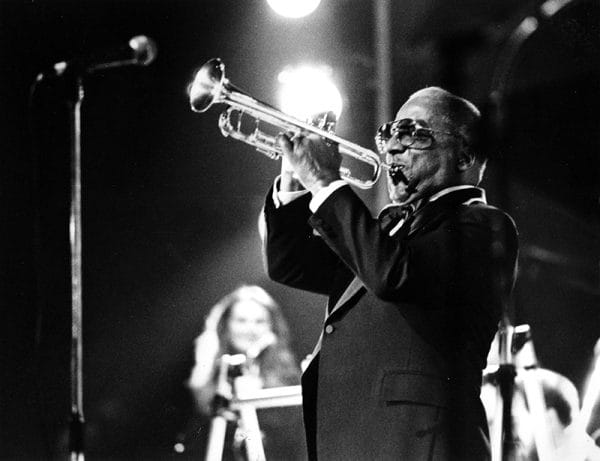 Erskine Hawkins at ALMHOF Induction
By 1953, Hawkins was forced to reduce the big band to a small combo, as swing music gave way to rhythm & blues and bebop, but the larger group occasionally had reunions. In the 1960s, he regularly played the Embers Club in New York City, and from 1967 to 1989 played the Concord Hotel in New York’s Catskill Mountain resort area and lived in Willingboro, New Jersey, with his second wife, Gloria Dumas. During his career he recorded dozens of songs, but he was most productive from 1936-1950, recording for the Vocalion and RCA Bluebird labels. In the early 1950s, Hawkins also recorded for Coral and King Records. His last recording was an album featuring a reunion of his old bandmates in 1971.
Erskine Hawkins at ALMHOF Induction
By 1953, Hawkins was forced to reduce the big band to a small combo, as swing music gave way to rhythm & blues and bebop, but the larger group occasionally had reunions. In the 1960s, he regularly played the Embers Club in New York City, and from 1967 to 1989 played the Concord Hotel in New York’s Catskill Mountain resort area and lived in Willingboro, New Jersey, with his second wife, Gloria Dumas. During his career he recorded dozens of songs, but he was most productive from 1936-1950, recording for the Vocalion and RCA Bluebird labels. In the early 1950s, Hawkins also recorded for Coral and King Records. His last recording was an album featuring a reunion of his old bandmates in 1971.
Hawkins received many awards and honors, including an honorary doctorate in music from Alabama State Teachers College in 1947. In 1978 he was among the first inductees into the Alabama Jazz Hall of Fame and was given a Lifework Award for Performing Achievement by the Alabama Music Hall of Fame in 1989. Since the mid-1980s his birthday has been celebrated each July at the “Function in the Junction” in Birmingham, and the park near the old Tuxedo Junction was renamed Erskine Hawkins Park in his honor. He returned regularly to his home town to receive these honors and to celebrate his birthday. Erskine died on November 11, 1993, at age 79, in Willingboro, New Jersey, and was buried in Elmwood Cemetery in Birmingham.
Additional Resources
Deffaa, Chip. In the Mainstream: 18 Portraits in Jazz. Studies in Jazz. New Brunswick, N.J.: Scarecrow Press; Institute of Jazz Studies, Rutgers University, 1992.
Hawkins, Erskine. The Original Tuxedo Junction. Sound recording. New York: Bluebird, 1989.
Oliphant, Dave. The Early Swing Era, 1930 to 1941. Westport, Conn.: Greenwood Press, 2002.

